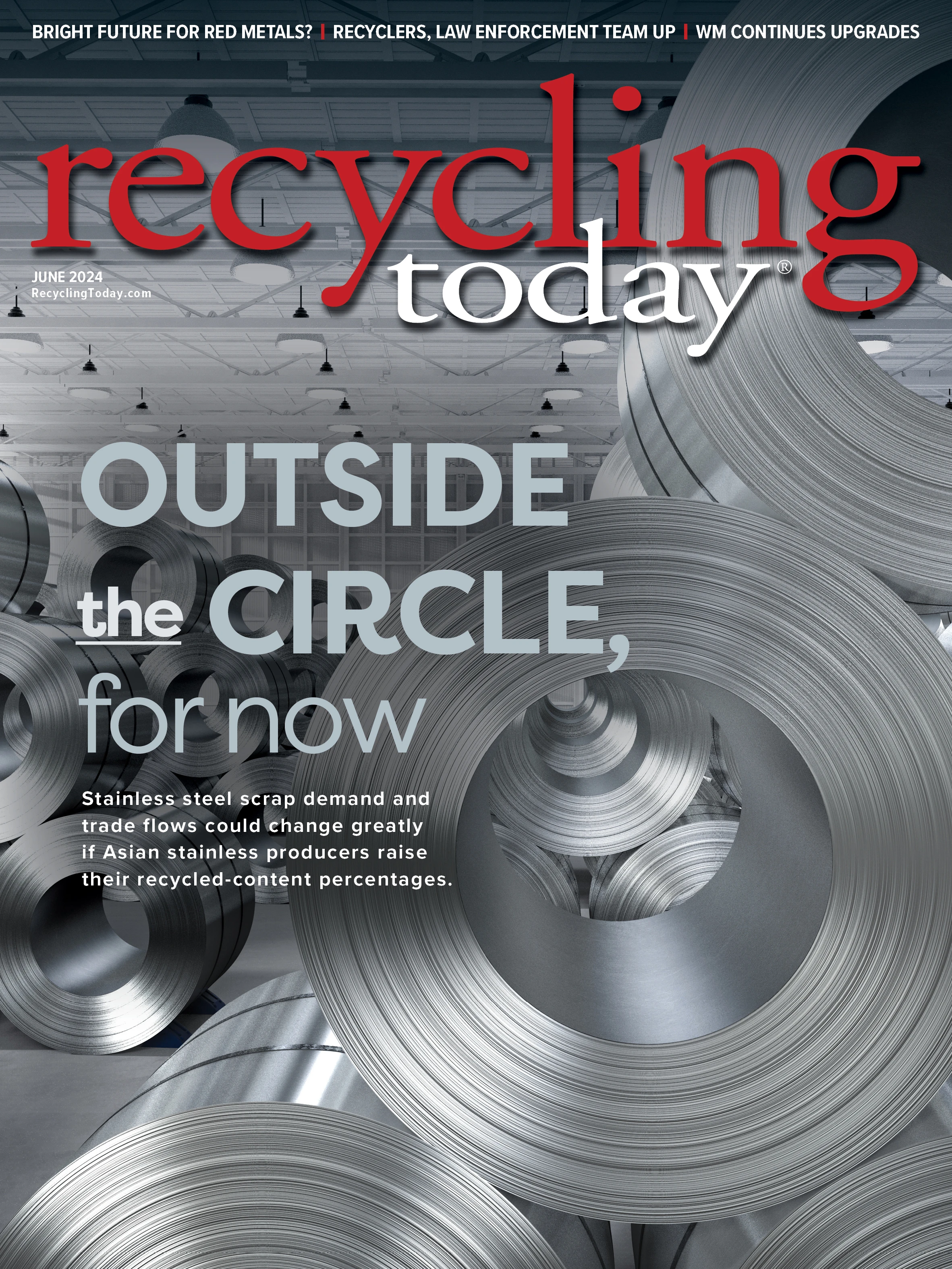
Veteran scrap processors and traders seldom have confronted a market where higher value and cleaner grades of red metal scrap are difficult to sell. Market and policy factors this century sometimes cause unprocessed and semiprocessed grades to face hurdles, but the global appetite for copper and brass scrap largely is reliable.
To what extent a predicted shift from fossil fuels to battery and alternative energy sources will create a shortage of copper remains to be seen.
A credible figure on red metal scrap consumption in 2023 and a flurry of decisions in corporate board rooms to boost or update melt shop capacity, however, point to reasonable expectations that red metal scrap will continue to find willing buyers in the years ahead.
A number worth noticing
In a March report, the Lisbon-based International Copper Study Group (ICSG) said that its 40-plus member nations produced more than 4.55 million metric tons (mmt) of recycled-content secondary copper in 2023.
That figure represents a 9.58 percent jump in output compared with 2022, or about 400,000 metric tons in volume.
The 4.55 mmt of secondary production made up 16.9 percent of global output in 2023, up slightly from recycling’s 16.35 percent contribution in 2022.
In 2023, primary copper production also grew—but not as fast as the recycled red metals sector. The more than 22.3 mmt of primary copper made in 2023 represent 5.3 percent output growth compared with the more than 21.2 mmt produced the prior year.

According to the ICSG report, mined output of copper did not grow nearly as fast last year as either primary or secondary production.
“Preliminary data indicates that world copper mine production increased by about 1 percent in 2023, with concentrate production and solvent extraction-electrowinning growing at a similar rate,” the ICSG says.
The world’s hunger for copper in 2023 checked in at a rate above the mined output increase but below growth rates for refinery production, with ICSG preliminary data suggesting that world apparent refined copper use grew by about 4 percent in 2023.
U.S. Census Bureau statistics for 2023 show 786,400 metric tons of secondary copper were produced last year, with brass and wire rod mills making about 668,000 metric tons.
Total U.S. secondary copper output in 2022 was 2.1 percent lower at 769,500 metric tons, with brass and wire rod mills responsible for most of that increase.
A much-discussed transition away from fossil fuels and toward battery, solar, wind and other competing energy sources would boost copper’s demand in the medium and long term. In the shorter term, several other factors could influence where red metal scrap flows the rest of this decade and could help determine its value.

Feeling energetic
In April, the International Copper Association (ICA), citing research by London-based CRU Group, predicted global demand for copper will rise from 28.3 mmt in 2020 to 40.9 mmt in 2040, increasing at a 1.85 percent compound annual growth rate (CAGR).
The Washington-based ICA says copper’s market share in the next two decades will be defined by regional trends and the green energy transition.
“This demand, which is forecast to be primarily driven by the development of energy infrastructure, is expected to ensure that wire rod remains the largest segment of total copper demand at an estimated 25 mmt by 2040, constituting approximately 60 percent of total demand share over the long term,” says Juan Brihet, a senior consultant at CRU.
CRU says copper tubing and heat pumps provide other anticipated sources of demand—including for secondary copper—in the decades ahead.
Some of that demand is poised to grow domestically. Melt shops operated by Aurubis, Wieland North America and Prime Materials Recovery (Ames Copper) recently started or are under construction and will compete for recyclable red metals in 2025 and beyond.
The overall global forecast likely is good news for copper-bearing scrap sellers that can benefit from steady to surging demand for copper and brass scrap domestically and overseas.
Regarding regional disparities, CRU’s research forecasts the strongest growth in copper demand is expected in India, with a 7 percent CAGR, followed by the Association of Southeast Asian Nations (ASEAN) region with a 6 percent CAGR. “Both regions are currently observing high growth in the manufacturing and construction industries,” the ICA says.
Metal recyclers in North America with access to seaports have been familiar with the Chinese market for decades. While India’s buyers often are associated with brass scrap in the U.S., their demand for copper scrap grades is growing steadily.
India and the ASEAN region are expected to see the highest growth rates in wire rod demand, but China is expected to remain the largest wire rod user.
North American recyclers who want to learn firsthand about red metals markets in China, India and the ASEAN region might wish to look into flights to Bangkok this summer.
The Recycling Metal Branch of the China Nonferrous Metals Industry Association is hosting its inaugural ASEAN Recycling Metals International Conference. The event, designed to connect the global recycling market with Chinese and ASEAN nonferrous scrap consumers, is June 17-19 at the Shangri-La Bangkok hotel.
The Material Recycling Association of India (MRAI) is returning to Bangkok this summer for its International Business Summit (IBS2024). The organization will host its summer conference July 25-26 at the Bangkok Marriott Marquis Queen’s Park.
While the energy transition likely will be a topic of discussion at both events, so will issues of scrap trading policy, short-term demand and price volatility—all of which affect whether red metal scrap recyclers and consumers can take part in the sector profitably.

Is there money to be made?
Growth in red metal scrap consumption won’t occur unless companies that collect, process and trade copper and brass scrap can attain a profit margin while doing so. The price of copper in the first four months of this year indicates plenty of room for such a margin, but the boosted price also carries with it considerable risks.
The price of copper on global metal exchange markets has been on an upward trend much of this year. The red metal spent the weekend of May 11-12 on the COMEX valued at up to $4.82 per pound as a futures price.
Copper’s London Metal Exchange (LME) price likewise continued to spike upward in early and mid-May, causing New York-based metals analyst John Gross, publisher of “The Copper Journal,” to refer to it as being “in the Twilight Zone.”
Gross says the contango position, with the cash price lower than the forward price, of copper on exchanges indicates it is readily available on the global market.
That circumstance caused Gross to consider financial speculation in the copper market. “So, if the market isn’t tight, what else is going on?” he says. “We can only imagine someone with deep pockets is attempting to manage the market, but that seems a bit too far-fetched—or does it?”
He draws a potential comparison to a copper bull market in 2005 and 2006, a stretch when he says the copper price was “hit back and forth like a tennis ball in a fierce competition.” That run-up led to a price plunge in 2008 that “was a sad chapter for just about everyone.”
Regarding current volatility, Gross believes a repeat performance of what occurred almost 20 years ago in the market is not guaranteed.
“To state the obvious, this is not good for the global copper industry,” he says. “Given the way copper is behaving, we wonder if someone is on the wrong side of this market.”
Being on the wrong side of the market is a place no recycler or trader wants to be when the value of copper soars upward. All things considered, however, a hungry market for secondary raw materials appears to be in the offing, with price volatility being a worrisome side effect.

Explore the June 2024 Issue
Check out more from this issue and find your next story to read.
Latest from Recycling Today
- NRC seeks speakers for October event
- LME identifies Hong Kong warehouses
- Greenville, Mississippi, launches aluminum can recycling program
- Cotton Lives On kicks off 2025 recycling activities
- Georgia-Pacific names president of corrugated business
- Sev.en Global Investments completes acquisitions of Celsa Steel UK, Celsa Nordic
- Wisconsin Aluminum Foundry is a finalist for US manufacturing leadership award
- MetalX announces leadership appointments






